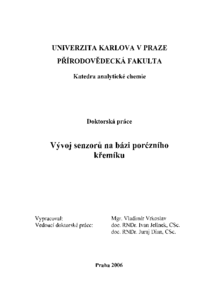Vývoj senzorů na bázi porézního křemíku
Development of sensors based on porous silicon
dizertační práce (OBHÁJENO)

Důvod omezené dostupnosti:
Dokument je přístupný pouze ve věcné databázi závěrečných prací.
Zobrazit/
Trvalý odkaz
http://hdl.handle.net/20.500.11956/95749Identifikátory
SIS: 198870
Katalog UK: 990021793980106986
Kolekce
- Kvalifikační práce [21483]
Autor
Vedoucí práce
Oponent práce
Mička, Zdeněk
Herynková, Kateřina
Volf, Radko
Fakulta / součást
Přírodovědecká fakulta
Obor
Analytická chemie
Katedra / ústav / klinika
Katedra analytické chemie
Datum obhajoby
25. 9. 2006
Nakladatel
Univerzita Karlova, Přírodovědecká fakultaJazyk
Čeština
Známka
Prospěl/a
5 Conclusion PS samples with defined macroporous structure were prepared and they were used as sensing layer in PL chemical sensors' concentration dependence of pL quenching response of standard PS was measured ro,ío*orogical set of linear alcohols in gas and liquid phase. From oU*'""a *tl"l"tion' of quenching sensitivity with dielecnic constant and saturated vapour it""ut" in gas and liquid phases follolrs: r. :r _L^-a io .nnrrolled bv dielectric - PL quancbing response of PS in liquid phase is controlled by streng*r ofmlYta - PL quenching response of PS in gas phase is controlled more by equilibriumconcentrationofanalýeinsideporousmatrix.Dielectric strength of analýe is not so important. PSsurfaceswerefunctionalizedwithcobaltphthalocyanine, polypyrrole, permethyl-6r-heptenoylamino-6I-deoxy B-cyclodextrins' methyl-lO-undeceonate and by oxidation' (The work is focused on using the first three compounds') We performed a measurement of concentration dependence of PL sensor response functionalized PS samples for selected organic species in gas phase' We can conclude that the PL quenching.",pň," was modiťred by functionalization of PS with selected compounds, due to change of surface polarity and molecular recognition. The magnitude of sensor response modification is dependent on kind of anallte' Another...
5 Conclusion PS samples with defined macroporous structure were prepared and they were used as sensing layer in PL chemical sensors' concentration dependence of pL quenching response of standard PS was measured ro,ío*orogical set of linear alcohols in gas and liquid phase. From oU*'""a *tl"l"tion' of quenching sensitivity with dielecnic constant and saturated vapour it""ut" in gas and liquid phases follolrs: r. :r _L^-a io .nnrrolled bv dielectric - PL quancbing response of PS in liquid phase is controlled by streng*r ofmlYta - PL quenching response of PS in gas phase is controlled more by equilibriumconcentrationofanalýeinsideporousmatrix.Dielectric strength of analýe is not so important. PSsurfaceswerefunctionalizedwithcobaltphthalocyanine, polypyrrole, permethyl-6r-heptenoylamino-6I-deoxy B-cyclodextrins' methyl-lO-undeceonate and by oxidation' (The work is focused on using the first three compounds') We performed a measurement of concentration dependence of PL sensor response functionalized PS samples for selected organic species in gas phase' We can conclude that the PL quenching.",pň," was modiťred by functionalization of PS with selected compounds, due to change of surface polarity and molecular recognition. The magnitude of sensor response modification is dependent on kind of anallte' Another...
